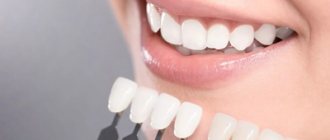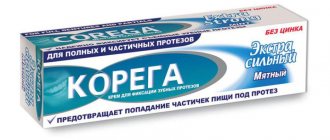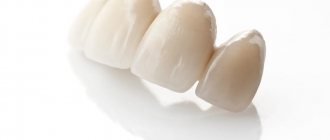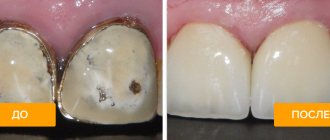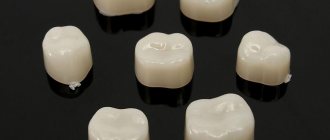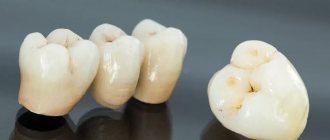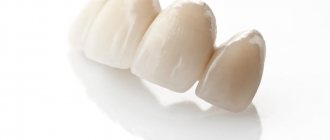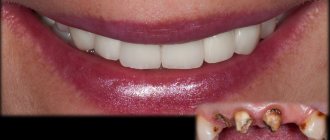Prostheses made from zirconium dioxide are almost ideal in quality; due to its properties, it is also used for the production of implants and abutments. On the other hand, the answer to the question of which is better in terms of cost is also obvious. Many patients are not satisfied with this option due to the high financial costs, so they choose metal ceramics as a cheaper solution.
Features of metal-ceramic crowns
The advantage of a metal-ceramic crown is that the frame is made from precious noble and non-precious alloys. The result is a super-strong base that rarely breaks. Structures made from natural materials are not attacked by microbes. Such crowns are excellent for hygienic types of prosthetics. There is no risk of damage to tissues or adjacent teeth; the material is not stained by food products. The service life of a metal-ceramic crown depends on proper care, correct installation, and the type of frame. If the base is made of gold, the design will retain its characteristics for up to 12-15 years.
Crowns for teeth: reviews
Unfortunately, it should be noted that patient reviews of dental crowns are more often negative than positive. And this is not due to the fact that artificial crowns themselves are bad, but due to the low quality of their dental manufacturing. The quality of crown manufacturing is influenced by many factors. And this is not only the quality of materials and equipment, but, above all, the professionalism and experience of orthopedists and therapists, as well as dental technicians.
The tooth was poorly prepared for a crown, the root canals were treated poorly - the crown and tooth needed to be redone. The impression of the teeth was poorly taken, cheap materials were used to make the crown - the crown needs to be redone again, and the tooth under the crown may begin to rot. You can read more about the stages of making crowns and what you need to pay special attention to here . We hope that our article: What are the best dental crowns reviews - was useful to you!
Sources:
1. Personal experience as a dentist, 2. “Orthopedic dentistry. Textbook" (Trezubov V.N.), 3. National Library of Medicine (USA), 4. https://www.realself.com/, 5. "Crowns and bridges in orthopedic dentistry" (Smith B.).
Advantages and disadvantages of metal-ceramic crowns
The main difference between a zirconium crown and a metal-ceramic crown is the risk of an allergic reaction to alloys made of nickel, chromium-nickel, gold, and other components. The metal oxidizes over time under the influence of saliva, and there is a possibility that a dark border will appear at the base of the prosthesis.
Advantages:
- Versatility - prosthetics of anterior teeth, high-quality restoration of chewing teeth.
- Aesthetics - the difference between metal-ceramic crowns and real teeth is difficult to determine visually, since the shade of the veneer is carefully selected.
- Maintainability - small chips, defects can be eliminated without removing the prosthesis.
- The fit is strong, there is no risk of developing caries due to the penetration of bacteria under the structure, but the fit is inferior in accuracy to zirconium, since the metal is cast and the zirconium crown is milled.
- Increased strength.
- High biocompatibility.
The disadvantages of metal-ceramic crowns include the need for significant grinding of teeth before installation. Prosthetics are not recommended if the teeth are severely damaged.
Comparison of zirconium and metal ceramics
To understand the difference between metal-ceramics and zirconium, here is a comparative table:
| Metal ceramics | Zirconium dioxide | |
| Price | Average | High |
| Presence of metal | Metal present, galvanic reactions possible | No metal |
| Possibility of allergies | Present due to the metal (reduced if a precious metal alloy is used) | No |
| Durability | 10-15 years | 15 – 20 years |
| Manufacturability | Made by hand | Application of high-tech computer equipment |
| Aesthetics | Fairly high level, can show through metal in certain lighting | Maximum naturalness, adjustable level of transparency |
| Strength | High | High |
| Preparing teeth for a crown | Strong grinding, removal of quite a large layer | Gentle treatment due to the design features and thin walls of the crowns |
Analyzing the data presented in the table, we can say that metal ceramics are better than zirconium only in terms of price. Indeed, the cost of restoring teeth in the oral cavity, especially large numbers, in the zirconium version will be significantly more expensive. However, if you focus not only on price, zirconium wins noticeably.
- Durability When comparing the service life of zirconium and metal-ceramics, we can nominally say that the first material will last twice as long. In practice, this figure is higher, and with proper oral care, zirconium bridges and crowns will serve their owners for a lifetime.
- Hypoallergenic Zirconium does not contain metallic inclusions, which means its range of applications is wider. In particular, such prostheses can be installed in “problem” categories of patients, including those with allergies to base metals. Let us immediately make a reservation that gold ceramics are also suitable for allergy sufferers, but their strength indicators are lower than those of zirconium dioxide orthopedic structures.
- Precision of the prosthesis The fact that a metal-ceramic prosthesis is made by dental technicians determines the likelihood (albeit minimal) of errors that will manifest themselves in a loose fit of the structure, and as a result - in a low level of comfort, rubbing of the mucous membrane and long-term adaptation. In the case of zirconium, the human factor is completely excluded. First, the oral cavity is scanned with a special scanner, then the resulting digital model is loaded into the milling machine program. As a result, a bridge or crown made of zirconium absolutely precisely matches the anatomical features of the dentition.
- Safety The purpose of installing a crown is to restore the damaged part of the tooth and help extend its working life. But unfortunately, this is not always what happens. There are situations when a tooth that has been heavily ground for a prosthesis becomes the next candidate for removal. Especially if, in preparation for prosthetics, a nerve had to be removed from it. A metal-ceramic crown consists of two layers - the first is metallic and has a gray tint, so the ceramic is applied to it in a rather thick layer to cover the gray tint. In this regard, it is necessary to remove a large layer of enamel, and often depulpate the tooth. The structural features of zirconium determine the need to remove a very thin enamel layer, and in 99% of cases they do not require nerve removal.
- Comfort It would seem that both metal ceramics and zirconium have a top ceramic layer that is ideally smooth. But the zirconium prosthesis has much less weight. Patients whose metal-ceramic bridges were replaced with zirconium bridges after wear, note the amazing lightness and high comfort of the new design.
Features of zirconium crowns
Zirconium dioxide crowns are a modern alternative to their analogues; they have no disadvantages or contraindications for the patient. The design is made of heavy-duty material and is 100% biocompatible, does not react with aggressive environments, and is not attacked by microbes. The main thing is the absence of a metal frame, which provokes allergies, oxidation, and the appearance of a dark stripe near the gums.
A prosthesis based on zirconium dioxide is distinguished by aesthetics, lasts 25-30 years, and does not darken. The method of its manufacture eliminates the risk of chipping, since the element is machined from a very hard monolithic block in a dental laboratory.
Zirconium crowns are made in different types:
- Monolithic - heavy-duty structures made from a whole block. Feature - the top layer is not covered with porcelain, the base and outer surface are the same. No risk of chipping.
- Classic - two-component design. The frame is made of zirconium dioxide, the top layer is porcelain lining.
The advantages of zirconium crowns over metal-ceramic ones are low-traumatic, safe prosthetics. Before installation, there is no heavy grinding of the enamel; there is no risk of injuring surrounding tissues.
Content
- What crowns are used?
- Comparison of zirconium and metal-ceramic crowns
- How to choose material
- The best dentures
Restoring missing teeth is a labor-intensive and quite expensive process. In addition, there are a lot of options and choosing the right one without the appropriate knowledge is problematic. Often, patients have to choose a crown for a tooth made of zirconium or metal-ceramics, since these are the options that are used most often than others.
Disadvantages of zirconium crowns
Disadvantages of durable structures
- Installation restrictions - it is not recommended to install dentures in the anterior region due to the low transparency of the base and limited choice of shades. But if the prostheses are made using Prettau technology, there are no restrictions due to the good aesthetics and natural color of the structures.
- Chips - this disadvantage is mitigated when choosing monolithic analogues.
- High price.
Orthopedic structures should be installed by an experienced doctor, which will reduce the risks of negative consequences for the patient.
How to choose a material for a denture?
The differences between metal-ceramics and zirconium determine the area in which the crowns will be installed. If prosthetics will be performed on chewing teeth and the patient is not inclined to spend too much, metal-ceramic crowns will be an excellent durable option.
If we are talking about the front teeth, you should pay attention to zirconium dentures. In the smile area, not only crowns are important, but also the condition of the gums. As can be seen from the table, one of the differences between metal ceramics and zirconium is the possibility of undesirable reactions of the metal with tissues, darkening of the gums. And this is extremely undesirable in the frontal zone of the dentition.
Benefits of zirconium crowns
Prostheses are lightweight and compete in strength with their metal counterparts. The patient quickly gets used to the design, which has low thermal conductivity. Does not feel discomfort when eating cold or hot foods.
Advantages:
- Biocompatibility - the inert material will not cause inflammation, gum irritation, allergies, or damage to soft tissues.
- Preservation of primary characteristics - color, structure, density, integrity do not change during operation. The material is not colored with food dyes.
- Strength - the metal-free frame is not afraid of cracks, does not bend, and the risk of chipping is minimized.
- Resistant to chewing loads - you can eat hard foods.
- Durability - at least 15 years, in practice with proper care - 25-30.
- Aesthetics - the structure of the translucent material resembles a real tooth. You can create an exact copy that cannot be distinguished from the natural series by color and density.
- Hypoallergenic - does not provoke allergies, is harmless to the body, there are no contraindications.
- Comfort - due to their low weight, perfect fit, dentures do not interfere or create pressure on the gums.
How to care for crowns -
If you have single crowns on your teeth, regular floss, brush, and toothpaste after each meal will usually be sufficient. However, when it comes to bridges, hygiene difficulties may arise. After all, the latter have an intermediate part (which restores the lost tooth), and it is under it that food debris accumulates, which is difficult to remove.
Therefore, for patients with bridges, as well as with periodontal pockets in the crown area, we recommend using special irrigators (Fig. 10), which allow you to clean hard-to-reach areas of the oral cavity from food debris and accumulation of soft plaque. These devices create a pulsating stream of high-pressure water, which is supplied through a special nozzle.
The main differences between a zirconium crown and a metal-ceramic crown
Difference between zirconium and metal-ceramic crowns:
| Indicators | Zirconium | Metal-ceramic |
| Strength of the finished structure | Increased | High |
| Bioinertness | 100% | There is a risk of metal oxidation under the influence of saliva. |
| Hypoallergenic | Allergic reactions to frame alloy components are possible. | |
| Lifetime | 25-30 years | 10-12 years |
| Aesthetics | Tall, teeth visually indistinguishable from your own | Low, there is a risk of a dark border appearing in the area |
| Production time | Fast | Long |
| Grinding of teeth before prosthetics | Minimal, no need to depulpate a living tooth | Significant, sometimes the tooth being restored is depulped |
| Light transmittance | High | Do not possess |
| Precision manufacturing | Jewelry - using CAD/CAM computer technology. No risk of gaps | The casting is done by a technician; the human factor may influence the accuracy. |
| Price | High | Low |
The Axioma Dental clinic invites patients for prosthetics and correction of complex dental defects. Highly qualified doctors, modern equipment - you are guaranteed an excellent smile.
Sources:
- Stepanov Alexander Gennadievich. Innovative concept of tooth-preserving medical technologies, 2018
- Fadeev A. Yu. Laboratory and experimental substantiation of the possibility of using zirconium fixed dentures. Abstract. dis. for the job application scientist step. Ph.D. Specialist. 14.00.21, 2002
- Maksimov G.V. Optimization of orthopedic treatment with metal-ceramic crowns on non-cast gold frames, 2004
Expert author:
Amiridi Marina Vladimirovna
Orthopedic dentist
The information presented in this article is provided for reference purposes and does not replace the advice of a qualified specialist.
At the first signs of illness, you should consult a doctor.
Tell us about us:
Service life of dental crowns, crown warranty
The normal lifespan of dental crowns is about 8-10 years. A prerequisite for such a long service life is the quality of the therapeutic preparation of the tooth (the quality of root canal filling), as well as the accuracy of the manufacturing of the crown. Precision should be understood, first of all, as the exact fit of the crown to the neck of the tooth, which is ensured by correct preparation of the tooth for the crown, taking an accurate impression, and good work of the dental technician (24stoma.ru).
According to statistics, in 60-70% of cases, root canals are filled poorly, which leads to inflammatory complications, the need to re-treat the tooth and even remove it. Moreover, most often chronic inflammation manifests itself just after the end of the warranty period, i.e. after 1 year. For comparison, in Germany the guarantee for prosthetics is on average 3-5 years. In addition, the service life of crowns is also affected by the level of oral hygiene of patients after prosthetics.
What's better
It is difficult to say for sure which type of alloy will be better. Undoubtedly, zirconium dioxide has a wide range of advantages compared to metal ceramics.
However, when making a decision, it is also important to take into account the individual characteristics of the body, possible contraindications and the degree of destruction and the number of damaged teeth. In addition, not every person can afford such an expensive prosthetic technique, which involves the installation of zirconium crowns.
In any case, the dentist will tell you which option to choose in order to obtain a high-quality result.
Possible problems and complications
| Metal-ceramic crowns | Zirconium crowns |
| Inconsistency between the color scheme of dentures and the natural dentition. Incorrectly selected prosthesis size. Poor fit of the crown. Increased tooth sensitivity. Fallout or displacement of the structure. | Increased tooth sensitivity. Poor fit of the prosthesis to the dental tissues as a result of improper turning. Unsatisfactory appearance of the crown. |
